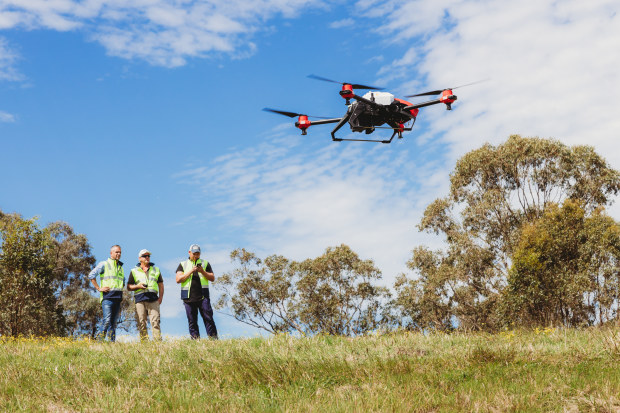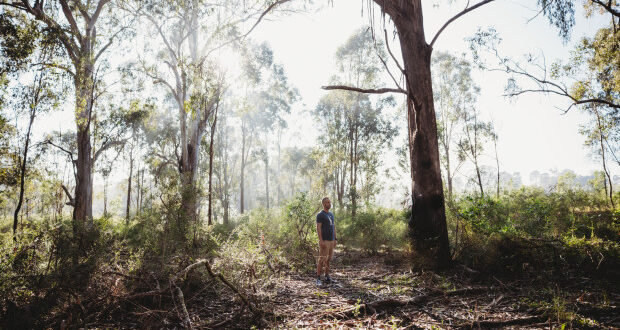“But it’s the collective effort of everything we do to curb the negative effect of climate change and I wanted to be part of the solution.
“Now, we’re not just planting trees, but fully restoring ecosystems by integrating Indigenous knowledge [from the regions] with a high-tech approach.”
Lord of the Trees is one of an ever-growing group of local start-ups tackling climate change, spanning areas such as carbon sequestration to vertical farming and battery storage.
Lord of the Trees drones can drop 400,000 seeds in 12 hours.
The company, which launched in September 2019, announced a pre-seed capital raise in March of $1.3 million, led by global venture capital fund Draper Associates.
The business works with landowners like mining companies, governments and farmers on reforestation projects, which create carbon credits. They are also regularly approached by corporations that need to offset their emissions and are looking for projects to fund.
However, in March, the Abbott government’s former chairman of the Domestic Offsets Integrity Committee sparked a debate on the integrity of the carbon credit scheme, saying up to 80 per cent of carbon credits issued by Australia’s clean regulator were flawed, with buyers left holding sham assets that had not reduced Australia’s carbon footprint.
This has inspired companies like Telstra to act of their own accord, with the telco planting 240 hectares of land in NSW to store greenhouse gas emissions.
Lord of the Trees has projects under way in Western Australia, NSW, and Queensland’s Daintree Rainforest. In September, it’s embarking on a project in Mexico with a tequila producer, centred on agave plants and saving an endangered species of bats that are the plant’s main pollinator.
The company employs local drone operators in each location, automating their flight paths so that they can be controlled remotely. This overcomes the scaling issues involved with owning its own fleet and having to transport the bulky machines long distances.
In Australia, it has worked with local First Nations’ people, embedding their knowledge on aspects such as fire management and seed-gathering practices in its operations, in an effort to improve success rates.
“Before we go out and plant, it’s a four-step process,” Maudous says. “We have to understand two things about the land, firstly the slopes (terrain and topography) and then the horizons – anything below ground level that we don’t see, which could be a substrate of calcium or a whether the soil composition is acidic or alkaline.
“That’s when the AI comes in – we take all the data and make predictions as to what and where to plant for optimal resources.”
The drones are close to two metres in diameter and take two people to manoeuvre.
An elite tree planter, Maudous says, could plant about 800 seedlings per day, working sunrise to sunset. Drones cover five football fields worth of land in an hour and plant about 400,000 seed pods in 12 hours.
“The scalability is very important to us. We needed to allow for rapid reforestation and rapid effects,” he says.

A Lord of the Trees drone in action.
“The Intergovernmental Panel on Climate Change [a United Nations body] says there is an estimated 1.7 billion hectares of tree-less land. That’s the size of China and the US combined, or about 11 per cent of all land.
“It represents an opportunity for 1.2 trillion native trees and could remove two-thirds of all emissions from human activities that remain in the atmosphere today, but it would take 50 to 100 years to have full effect.”
Reforestation projects can take years to complete. For example, at a mine site, the land has been severely disrupted and work is needed to repair the soil, before trees can be planted.
Maudous says the first year of a project needs to be spent “rebuilding the mother forest”, ensuring the soil ecology is right, there are earthworms present and the bacteria needed to sustain life.
Without this effort, the success rate of seedlings turning into trees is only 15 to 20 per cent after two years, whereas Lord of the Trees has a minimum 70 per cent success rate from the seeds planted, Maudous says.
While it has support from big business clients, it is also poised to kick off a Series A round in the next few months to give the business additional firepower.
“We have a lot more projects in the pipeline, especially to do with blue carbon. There’s a big race for anything to do with decarbonisation from big corporates … and blue carbon – carbon captured by wetland, seagrass and mangroves – generates three to five times more credits than trees for the same effort.”
 Unmanned Aerial Vehicle The latest drone news
Unmanned Aerial Vehicle The latest drone news




